|
FAQs on Marine Algae Identification 35
Related Articles: Avoiding Algae Problems in Marine System,
Algae
Control, Marine Maintenance,
Nutrient Control and Export,
Marine Scavengers, Snails, Hermit
Crabs, Mithrax/Emerald
Green Crabs, Sea Urchins, Blennies, Algae
Filters, Ctenochaetus/Bristle Mouth
Tangs, Zebrasoma/Sailfin Tangs,
Skimmers, Skimmer Selection, Marine Algae, Coralline Algae, Green Algae, Brown
Algae, Blue-Green
"Algae"/(Cyanobacteria), Diatoms, Brown
Algae,
Related FAQs: Algae ID Visual
Guide, Marine Algae ID 1,
Marine Algae ID 2, Marine Algae ID 3, Marine Algae ID 4, Marine Algae ID 5, Marine Algae ID 6, Marine Algae ID 7, Marine Algae ID 8, Marine Algae ID 9, Marine Algae ID 10, Marine Algae ID 11, Marine Algae ID 12, Marine Algae ID 13, Marine Algae ID 14, Marine Algae ID 15, Marine Algae ID 16, Marine Algae ID 17, Marine Algae ID 18, Marine Algae ID 19, Marine Algae ID 20, Marine Algae ID 21, Marine Algae ID 21, Marine Algae ID 23, Marine Algae ID 24, Marine Algae ID 25, SW Algae ID 26, SW Algae ID 27, SW Algae ID 28, SW Algae ID 29, SW Algae ID 30, SW Algae ID 31, SW Algae ID 32, SW Algae ID 33, SW Algae ID 34,
SW
Algae ID 36, SW Algae ID 37, SW
Algae ID 38, SW Algae ID 39, & Marine Algae Control FAQs 2, Marine Algaecide Use, Nutrient Limitation, Marine Algae Eaters, Culturing Macro-Algae; Controlling: BGA/Cyano, Red/Encrusting Algae, Green Algae, Brown/Diatom Algae,
|
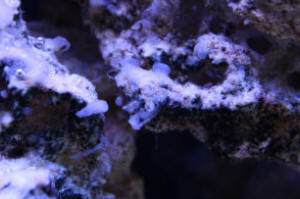
|
|
ID Help, Macro or Bubble? 12/14/11
Hello to the good folk of WWM!
<Hello Rey>
Can you help identify what type of Macro Algae or Bubble Algae I
have growing here? Its growing on several different rocks.
They are very small, maybe the size of a small chocolate chip and
shaped like a leaf. Very soft to the touch. Anything to worry
about or will it run its course?
<Some Rhodophytes have also been dubbed by some as Red
Valonia, but your macro algae appears to be a Rhodophyte,
Botryocladia skottsbergii. I'm not sure if they spread like
Valonia so I will ask Bob for his input in this regard.>
<<Not nearly as robust, invasive as Valonia.
RMF>>
Thanks!
<You're welcome. James (Salty Dog)>
Rey
|
|
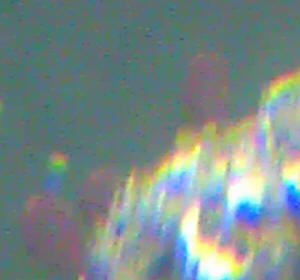 [1]%20crop.jpg)
|
|
Dear Bob,
Hope you can help. I have a 600l mixed
reef that is running smoothly apart from what I can only describe
as reef snot! I repeatedly get a covering of this mucus type
stuff on several rocks. I have attached a photo, however it is a
light brown in colour and occasionally forms bubbles. It is
loosely attached and easily syphons out but generally regrows
quite quickly within a couple of days; occasionally it may take a
week to regrow, but always seems to come back. If left, it will
grow into large globules and strings that sometimes detach in the
flow. The problem started a couple of months back.
Do you have any idea what it is and
how i can get rid of it? I suspect it could be some kind of
bacterial algae?
Some info about my reef if it helps:
It has been running approx 2 years and is a standard Berlin type
system with mature rock. I utilise a good quality protein skimmer
which is slightly oversized and iron based phosphate remover in a
Deltec fluidiser. Flow is moderate to strong using Tunze streams.
Magnesium, calcium and KH are kept in check with balling lite
using Fauna Marin salts apart from KH for which I use standard
bicarb of soda from the local cash and carry (£4 for
3kg!)
Water parameters are good and stable
with nitrate and phosphate being unreadable on Salifert test kit
and a Hanna tester. I've attached a general photo of the tank
for reference.
Many thanks and best regards,
Ian, by email
|
|
 |
Ian, I have seen, even personally
experienced this sort of light brown coloured slime
issue'¦ and taken a look at bits of it through my handy
dandy Mattel-Intel QX3 microscope. As far as I can tell, most of
the life here is/was Dinoflagellates'¦ single celled
algae with whip-like and a girdling flagella (for
locomotion)'¦ along with a mix of other algal groups
members, Protists'¦ There are a few standard approaches
to limiting such growth. These include nutrient limitation
(through good skimming which you have, use of some chemical
filtrants, water changes, gravel vacuuming, the use of in-place
and remoted DSBs/Deep Sand Beds'¦) and nutrient
introduction prevention (rinsing frozen/defrosted foods, using
foodstuffs that are discrete and completely digestible and
palatable so that they're consumed'¦). Importantly,
attention to raised and sustained RedOx (covered in an article in
this issue of UM, do read this) perhaps through the introduction
of Ozone, or other means e.g., increased pH, above 8.5 during the
day, low of 8.3 during the night. All these are activities that
favour other organisms that will out-compete noisome algae for
nutrients.
You mention the possibility that this
mass is bacterial algae, likely referring to Cyanobacteria or
Blue-green algae. Both Dinoflagellates and BGA are indeed slimy,
and the latter does occur in several colours, though rarely
brown. Determination of group can be readily determined by
microscopic examination; the BGA being Monerans and like bacteria
lacking nuclei and having but one circular strand of DNA.
You also note the age of the system
and that it is well-established. I encourage you to either add,
or renew some part of your live rock here'¦ this will
add to RedOx, and replenish your likely depauperate mix of life
on and in the rock and substrate. The ecological improvement will
also grant you relief from the brown slime problem.
The lack of detectable nitrate and
phosphate are telling'¦ these nutrients may be being
taken up by the undesirable biota here, or may be dangerously
limited, otherwise unavailable to your purposeful livestock here.
To put this bluntly, I would be pro-active in reducing, ridding
your system of the brown slime.
|
Green Hair Algae 11/26/11
<We require that people send files of no larger size
than a few hundred Kbytes. See WWM re Chlorodesmis. Bob
Fenner>
For a almost 6 months we've been losing a battle to
green hair algae. Our 250 reef tank had been doing well
until the back of the glass was covered with hair algae.
Not thinking/realizing it was time to add more to our CUC,
we scraped the back glass ourselves and the hair algae
attached to the rocks. We tried manually cleaning the rocks
but the few threads we missed clung to new rocks and
continued to grow. When I have browsed your website, the
closest algae to ours appears to be turtle weed. I'm
attaching
pictures to see if you could please help us identify our
hair algae. Our magnesium was low (1120) and our nitrates
were at 10. We are raising the magnesium and continuing to
run carbon and phosphate removers. We have added additional
types of macro algae to our refugium, changed our lights,
reduced the light period of our MH to only 6 hours but
still have the VHOs on 4 hours prior to the MH and 4 hours
after the MH. We have also reduced feedings and recently
added snails (Astrea turbo snails). We had been
trying to use Mexican Turbos but hadn't had much luck
with them. No one wants to eat it and we can't seem to
kill it. Any type of ID help would be greatly appreciated.
Thanks for your help and guidance.
|
|
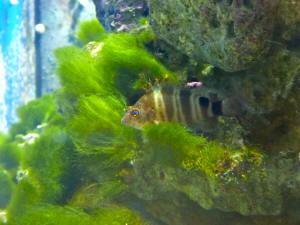 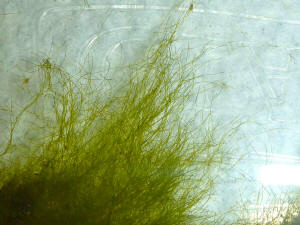
|
Re: Green Hair Algae 11/26/11
Here are the smaller images, I will check out Chlorodesmis.
Thanks
<Ahh; I/we thank you. The 50 Megs of space our email has
was past 76% full>
For almost 6 months we've been losing a battle to green
hair algae. Our 250 reef tank had been doing well until the
back of the glass was covered with hair algae. Not
thinking/realizing it was time to add more to our CUC, we
scraped the back glass ourselves and the hair algae attached
to the rocks. We tried manually cleaning the rocks but the
few threads we missed clung to new rocks and continued to
grow. When I have browsed your website, the closest algae to
ours appears to be turtle weed.
<Ah yes>
I'm attaching pictures to see if you could please help us
identify our hair algae. Our magnesium was low (1120) and our
nitrates were at 10. We are raising the magnesium and
continuing to run carbon and phosphate removers.
<Hopefully these won't starve other live, your
livestock here>
We have added additional types of macro algae to our
refugium, changed our lights, reduced the light period of our
MH to only 6 hours but still have the VHOs on 4 hours prior
to the MH and 4 hours after the MH. We have also reduced
feedings and recently added snails (Astrea turbo snails). We
had been trying to use Mexican Turbos but hadn't had much
luck with them. No one wants to eat it and we can't seem
to kill it. Any type of ID help would be greatly appreciated.
Thanks for your help and guidance.
<Welcome... do consider a (remoted) DSB as well. BobF>
Re: Green Hair Algae 11/27/11
Thank you so much for your response. I'm really perplexed
to how we have turtle weed growing in our tank. Besides
installing a remote DSB are there any other suggestions you
might add?
<Mmm, the usual trials for potential predators, other
means of nutrient deprivation... Read here:
http://www.wetwebmedia.com/marine/maintenance/maintindex.htm
scroll down to the Algae Control tray... BobF>
None of our fish will eat it but it seems like some of the
Astrea snails are working on it. I have ordered some Mexico
Turbos to see if they will help too. Any other suggestions?
Thank you again. |
|
|
Algae id, 10/29/11
Good evening,
<Hi>
Can you help me with an id on this algae? What kind does this
look like?
Thanks
Rob
<Looks like Cyano with maybe some diatoms mixed in. See here
for more http://www.wetwebmedia.com/bluegralgae.htm
.>
<Chris>
|
|
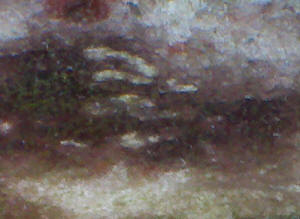
|
|
Algae Identification -- 10/12/11
Hello Crew,
First off, thanks for all the years of being here for us!
<Welcome>
I noticed this form of algae popping up all over my live rock
over the last week. The only algae it resembles at all to me is,
Acetabularia acetabulum (mermaid's wine glass).
Can you please help me identify it and let me know if it could
take over my tank. The algae is white with a green stem hard to
the touch, looks like a daisy, and does not retract when touched;
but the flower (as I'm calling it) portion of it falls off if
I try to move it back and forth.
My reef tank is 30 gallons with a 20 gallon sump. I am running a
CPR Aquafuge Small and a protein skimmer.
Here are a couple of pictures of the algae:
Thanks Again,
Nick
<Mmm, I think this is an Octocoral of some sort... A
Clavulariid... Do see the Net re... Bob Fenner>
|
|
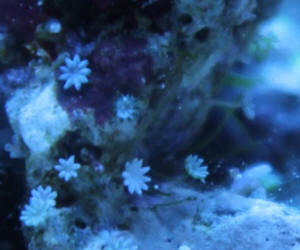
|
Reef Tank Fuzzies
9/12/11
Hello Guys,
<Babak>
I have been having quite a time trying to figure out what's growing
on one of my coral skeletons, it resembles green hair algae yet has no
color or is perhaps white or grey and seems to branch in some
places.
<Mmm, digitate... likely is an algae of some sort... Really need to
look at under a lowish power microscope to tell for sure>
Does anyone have any idea what this is? I was told that it may be some
type of sponge but I don't feel
that's right.
<Not likely a sponge if very flexible... Algae come in all
colours... yours is likely a blue-green/Cyanophyte... See WWM re,
including limiting nutrient, other means of control. Bob Fenner>
Thanks,
Bob
|
Re Pest Anemone/Aiptasia ID, now algal
mat ID 7/31/11 - 8/1/11
Thanks for the confirmation, James.
<You're welcome.>
I got a Magnesium test today. First test came out at 1450. It
appears that is close to normal...I'm still reading up on
Magnesium in general.
<I would not let this get any higher and lean toward a range
of 1250-1350ppm.>
<There will be a magnesium article in our latest issue of WWM
Digital Magazine which should be released very shortly.>
I'll test tomorrow just to ensure there was no operator
error. Also, I attached a few more pics of the algae
'mat' I have on my live rock. No problem if you can't
ID it.
<I see no pic attached but no need to resend, just concentrate
on lowering your nitrate level.
May want to read here. http://www.wetwebmedia.com/nitratesmar.htm
>
I think I'm going to work with a lemon juice or vinegar
solution before buying any chemical additive for the Aiptasia.
Thanks, again for your time.
<You're welcome. James (Salty Dog)>
Re Pest Anemone/Aiptasia ID 7/31/11 - 8/1/11
Oops, sorry Adam, I do see the pics. Mistakenly looking for them
on the reply page which will not show attachments. Cannot
identify exactly, but a common mat type algae that generally
develops within newer systems and should disappear as you lower
your nutrient/nitrate levels. You may also want to hire a few
more hands for your clean up crew.
James (Salty Dog)>
|
|
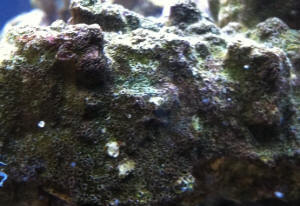
|
|
Is this bubble algae?/what kind of
coral is this? 7/15/11
Hello everyone at WWM,
<Tim>
I got this Zoanthid about 7 weeks ago at my LFS for $5.00. I had
it on a rack and just moved it on to a rock. Is this bubble algae
to the right of it?
<Mmm, yes>
I have never had that type of algae. I have not glued the piece
yet so I can take it out and remove if that is what it is,
don't want it spreading.
<Mmm, see WWM re Valoniaceans>
I also heard that it is easier to remove if the bubbles are
bigger. In the second picture I won this at a frag swap and
forgot to ask what it was.
Is it Favia?
<I do think it is of this genus, yes>
Thanks for your help it is much appreciated.
Tim
<Welcome! Bob Fenner>
|
|
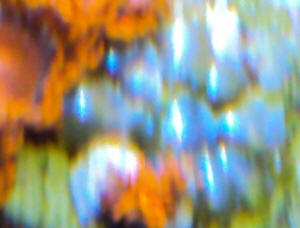 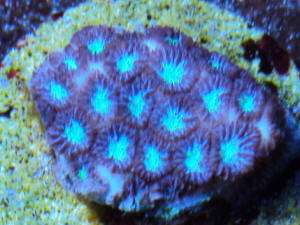
|
|
Clearish Dinoflagellates? 6/7/11
Good Morning Crew,
I have what appear to be clear to white dino's all over my
rockwork.
<Mmm, maybe>
Tank is a 58 gallon w/ a Tunze 6045 and 6025 for circulation,
BM100 v2 skimmer. It's long and gets bubbles on it, has a
slimy texture,
<Here's a clue...>
and has spread everywhere. Tank is a mixed reef. The best way to
describe it is it has the appearance and texture of snot, with
some bubbles. I feed mainly NLS pellets, which rarely do any go
uneaten. It's been around for a couple months, and
doesn't show any sign of going away. Scrubbing rocks
hasn't helped. Any ideas what this is? I'll attach a
picture.
Thanks,
Seth
<Likely this is a mix of species/organisms... the slimy
component Cyanobacterial... Need microscopic examination, perhaps
some simple to not staining to define... But the usual
approaches: nutrient limitation,
removal, competition and predation... See WWM re algal control,
are your guide to reducing, eliminating this mess. Bob
Fenner>
|
|

|
|
|

